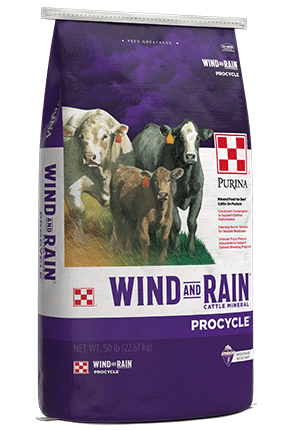
Rumen Microbes in Cows 101
Management : Cow & Calf
Nutrition : Supplements

You give a lot of thought to your cattle and their well-being. However, one thing you likely haven’t given much consideration to is rumen microbes.
What are the microbes found in the rumen of cattle? Why should you care?
Rumen microbes include the protozoa, bacteria and fungi that live inside the rumen, one of the cow’s four stomach compartments. In just 1 milliliter of rumen fluid, you can find 25 billion bacteria,1 10 million protozoa2 and 10 thousand fungi.3 That’s more than a quadrillion (1,000,000,000,000,000) rumen microbes per cow.4
What and how we feed cows affects which microbes grow, how feed is utilized and the nutrients available to the cow.
Bloat occurs when a cow is unable to rid herself of excess gas that is produced when microbes break down feed. Sub-acute rumen acidosis (SARA) can result when the population of bacteria is unbalanced.
If the pH of the rumen gets below 5.4 and stays there, the microbe population can produce lactic acid, which can build up and paralyze muscles, including the diaphragm. The animal could stop breathing and die because of an imbalance in the rumen microbe population.
One strategy includes minimizing abrupt changes in the diet, which can make things to go awry quickly. Another strategy is to encourage cattle to snack eat to optimize rumen microbe populations.
Supplements with intake control properties help send metabolic signals to the cow, telling her it’s time to stop eating the supplement and go graze. After a day of small, snack-size supplement portions, cattle don’t return famished to eat a “super-size” portion – which can cause a broad shift in rumen pH.
The science of nutrition is having a balanced diet and providing nutrients to the cow to keep rumen microbes from going bad.
You aren’t feeding your cows, you are feeding the rumen microbes inside the cow. It’s your success or failure in feeding the rumen microbe population that impacts animal performance.
Does your nutrition program stack up? Find out with a Proof Pays feeding trial.
1Leedle, J. A., M. P. Bryant and R. B. Hespell. 1982. Diurnal Variations in Bacterial Numbers and Fluid Parameters in Ruminal Contents of Animals Fed Low- or High-Forage Diets. Applied and Environmental Microbiology. Vol. 44, No. 2, p. 402-412.
2Clarke, R. T. J. 1965. Diurnal Variations in the Numbers of Rumen Ciliate Protozoa in Cattle. New Zealand Journal of Agricultural Research. Vol 8, No. 1.
3Joblin, K. N. 1981. Isolation, Enumeration, and Maintenance of Rumen Anaerobic Fungi in Roll Tubes. 42(6):1119-1122.
4Jurgens, M. H., K. Bregendahl, J. Coverdale and S. Hansen. 2012. Animal Feeding and Nutrition. Vol 11.
What are the microbes found in the rumen of cattle? Why should you care?
Rumen microbes include the protozoa, bacteria and fungi that live inside the rumen, one of the cow’s four stomach compartments. In just 1 milliliter of rumen fluid, you can find 25 billion bacteria,1 10 million protozoa2 and 10 thousand fungi.3 That’s more than a quadrillion (1,000,000,000,000,000) rumen microbes per cow.4
What do microbes in the rumen of cows do?
Rumen microbes work together to break down what the cow eats, turning the feed into energy and protein for the cow. They produce volatile fatty acids for additional energy, and the microbes themselves are an important protein source at the end of their life cycles.What and how we feed cows affects which microbes grow, how feed is utilized and the nutrients available to the cow.
What can go wrong?
A change in rumen pH can wipe out the entire population of rumen microbes. Poor quality feed, abrupt diet changes or transportation stress can cause changes to rumen pH.Bloat occurs when a cow is unable to rid herself of excess gas that is produced when microbes break down feed. Sub-acute rumen acidosis (SARA) can result when the population of bacteria is unbalanced.
If the pH of the rumen gets below 5.4 and stays there, the microbe population can produce lactic acid, which can build up and paralyze muscles, including the diaphragm. The animal could stop breathing and die because of an imbalance in the rumen microbe population.
What can I do to maintain rumen pH?
Rumen pH is never constant – it goes down after each meal and starts to rise when the animal chews its cud. The goal for rumen pH should be to stay at 5.9 or higher, and you can implement strategies to keep it there.One strategy includes minimizing abrupt changes in the diet, which can make things to go awry quickly. Another strategy is to encourage cattle to snack eat to optimize rumen microbe populations.
Supplements with intake control properties help send metabolic signals to the cow, telling her it’s time to stop eating the supplement and go graze. After a day of small, snack-size supplement portions, cattle don’t return famished to eat a “super-size” portion – which can cause a broad shift in rumen pH.
The science of nutrition is having a balanced diet and providing nutrients to the cow to keep rumen microbes from going bad.
You aren’t feeding your cows, you are feeding the rumen microbes inside the cow. It’s your success or failure in feeding the rumen microbe population that impacts animal performance.
Does your nutrition program stack up? Find out with a Proof Pays feeding trial.
1Leedle, J. A., M. P. Bryant and R. B. Hespell. 1982. Diurnal Variations in Bacterial Numbers and Fluid Parameters in Ruminal Contents of Animals Fed Low- or High-Forage Diets. Applied and Environmental Microbiology. Vol. 44, No. 2, p. 402-412.
2Clarke, R. T. J. 1965. Diurnal Variations in the Numbers of Rumen Ciliate Protozoa in Cattle. New Zealand Journal of Agricultural Research. Vol 8, No. 1.
3Joblin, K. N. 1981. Isolation, Enumeration, and Maintenance of Rumen Anaerobic Fungi in Roll Tubes. 42(6):1119-1122.
4Jurgens, M. H., K. Bregendahl, J. Coverdale and S. Hansen. 2012. Animal Feeding and Nutrition. Vol 11.

.png?width=300&height=430&ext=.png)


